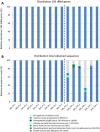First continuous marine sponge cell line established
- PMID: 37031251
- PMCID: PMC10082835
- DOI: 10.1038/s41598-023-32394-x
First continuous marine sponge cell line established
Abstract
The potential of sponge-derived chemicals for pharmaceutical applications remains largely unexploited due to limited available biomass. Although many have attempted to culture marine sponge cells in vitro to create a scalable production platform for such biopharmaceuticals, these efforts have been mostly unsuccessful. We recently showed that Geodia barretti sponge cells could divide rapidly in M1 medium. In this study we established the first continuous marine sponge cell line, originating from G. barretti. G. barretti cells cultured in OpM1 medium, a modification of M1, grew more rapidly and to a higher density than in M1. Cells in OpM1 reached 1.74 population doublings after 30 min, more than twofold higher than the already rapid growth rate of 0.74 population doublings in 30 min in M1. The maximum number of population doublings increased from 5 doublings in M1 to at least 98 doublings in OpM1. Subcultured cells could be cryopreserved and used to inoculate new cultures. With these results, we have overcome a major obstacle that has blocked the path to producing biopharmaceuticals with sponge cells at industrial scale for decades.
© 2023. The Author(s).
Conflict of interest statement
The authors declare no competing interests.
Figures





References
Publication types
MeSH terms
LinkOut - more resources
Full Text Sources
Research Materials

